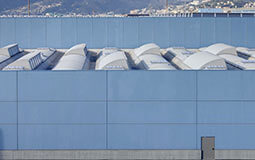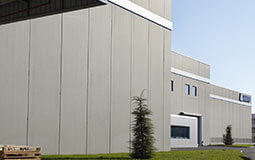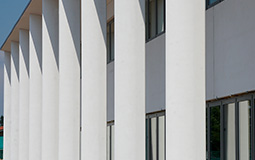Aesthetics and functionality at the heart of every panel
They combine aesthetics and functionality, technique and the utmost creative freedom: there is a wide range of Magnetti Building panels and it is characterised by its performance and countless composition possibilities, that contrivute towards defining the identity of the building itself. It is possible to choose from horizontal or vertical panels, carefully matched and integrated into portals, projecting roofs as well as solutions for corners and shutters.

TX Active
The emissions of nitric oxide (NOx) are primarily responsible for the architectural deterioration of buildings. Magnetti Building was the first company in Italy to create a line of solid wood blocks for masonry and infill wall panels capable of reducing several pollutants.
The heart of this family of products consists of a type of TX Active concrete, with photocatalytic properties, that when irradiated with light, it oxidates the toxic substances that deposit on buildings (PM10, nitrogen oxides and dioxides, aromatic polycondensates, benzene, carbon monoxide) and transforms them into non-toxic compounds.
Advantages
Self-cleaning
Grease, dust and acid rain cause the proliferation of microorganisms that damage the surfaces of buildings. Over time, the anti-fouling effect of the panels preserve the brilliance of the colour and, consequently the aesthetic qualities of the works.
Versatile
Available in a wide range of colours and finishes, these products can be used to create any kind of cladding.
Durable and no need for maintenance
These products can withstand freeze/thaw cycles, the actions of sodium chloride, adverse weather conditions and ageing. No maintenance is required.
Sustainable
These products comply with current legislation, they are an ecological solution and can be used in sustainabile construction.
The use of photocatalytic concrete is becoming increasingly popular throughout Europe. The most significant applications include the Dives in Misericordia church in Rome, designed by architect Richard Meier and the City of Music and Fine Arts in Chambéry, France.
The evolution of finishes
Finishes are by far the most advanced that can be found in the architectural concrete field. These originate from special binding agents that are dosed and combined with selected mixtures of marble, granite and other rocks. They are subjected to special washing, grinding down, bush-hammering and grooving treatments to create surfaces characterised by natural hues and soft colour variations.
This entire process is expressed at its highest level in the Kromax® line, a construction element with high architectural value.
The panels are obtained with a mixture of concrete, marble granulate or river grit and oxides, with the addition of chemical additives that make the mixture more resistant and fluid.
TYPES
The combination of different finishes also inside the same infill wall panel makes it possible to obtain unique chromatic effects. It is in this way that in the space of only a few metres, a facade may be treated with the entire range of finishes and treatments, from the washed, smooth texture to that of the polished, bush-hammered nature.

This finish is obtained by casting the mix onto a rubber matrix that is used to stamp relief patterns on the exposed concrete surface. Concrete provides many possibilities to create different surface effects thanks to the pattern stamped by using matrices.

The beauty of the washed surface applied to exposed concrete, using low penetration depth lacquer retarders. The final effect makes the grain structure of traditional concrete particularly appreciable. This finish also makes it possible to obtain different colour options by using iron oxides.
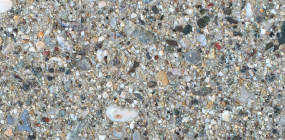
The finish that appears is that of the external surface of the product with the traditional texture of cementitious paste that completely covers the concrete aggregates.
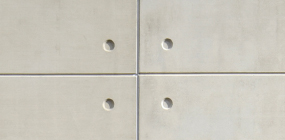
With the use of skilfully mixed grey marble granulate with a varying grain sizes, finishes can be obtained that are similar to the effect given by the Ceppo Lombardo, the stone par excellence used in Lombard architecture. The final polishing, both in the glossy and coarse, unfinished versions, is definitely the treatment that enhances this type of finish the most.
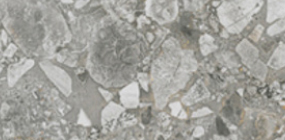
This finish is obtained by starting with the same production method used so as to achieve the natural finish, yet the surface is then treated with paints/varnishes of the required colour.

This finish is obtained from cast concrete bottom formwork; this can be through-body coloured by using oxides. Depending on the colour required, grey concrete is used to obtain dark colours or white concrete for light colours.
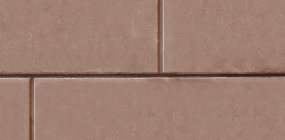
The brilliance of glass combined with the glossiness of polishing. The addition of round glass pebbles or pieces of shattered glass to the marble grit mix together with other raw materials provide extremely interesting chromatic reflections.
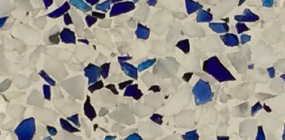
This finish faithfully represents the classic sharp-edged exposed brickwork used as the ornamental cladding of vertical architectural building enclosures. The bricks are manually positioned on top of a rubber matrix applied to the bottom of the mould. Therefore, the hand guard becomes a very important part of the building, fulfilling also a protective function.
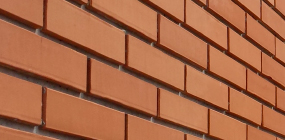
This finish has a layer of river gravel or marble grit that, after a day of maturation and thanks to the lacquer retarder previously applied to the surface, can be washed using the hydro-brushing machine and water jets. This process enhances the most natural appearance of the stone.
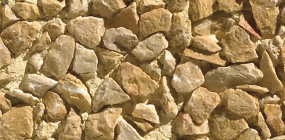
Bush-hammering highlights the rusticity of the surface, enhancing the aggregates of which the mix is composed. This process digs into the surface of the panel, toning down its colour and revealing its natural, inner colour. It is obtained by a similar jet used to achieve the washed finish, the surface of the panel is treated with a rotating disc fitted with iron tips, that uniformly carve into concrete and stone.
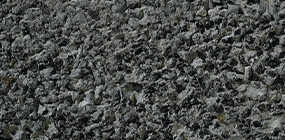
Polishing lays the mixture material bare, revealing the hidden qualities of particular mixes of selected marble. This is a refined, high-gloss finish, obtained by carrying out the same procedure to achieve the bush-hammered effect: the treatment is performed using specific polishing plates with increasingly finer abrasive particles. The final treatment makes it possible to polish the panel and to enhance refined aggregates.
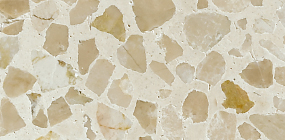
Are you interested in our panels?
Contact Magnetti Building now



